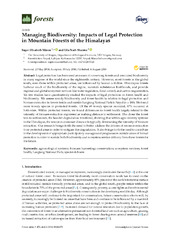| dc.contributor.author | Måren, Inger Elisabeth | |
| dc.contributor.author | Sharma, Lila Nath | |
| dc.date.accessioned | 2019-06-21T13:15:43Z | |
| dc.date.available | 2019-06-21T13:15:43Z | |
| dc.date.issued | 2018-08-04 | |
| dc.Published | Måren IE, Sharma LN. Managing biodiversity: Impacts of Legal Protection in Mountain Forests of the Himalayas. Forests. 2018;9(8):476 | eng |
| dc.identifier.issn | 1999-4907 | en_US |
| dc.identifier.uri | http://hdl.handle.net/1956/20345 | |
| dc.description.abstract | Legal protection has been used as means of conserving forests and associated biodiversity in many regions of the world since the eighteenth century. However, most forests in the global south, even those within protected areas, are influenced by human activities. Himalayan forests harbour much of the biodiversity of the region, maintain subsistence livelihoods, and provide regional and global ecosystem services like water regulation, flood control, and carbon sequestration. Yet few studies have quantitatively studied the impacts of legal protection on forest health and biodiversity. We assess woody biodiversity and forest health in relation to legal protection and biomass extraction in forests inside and outside Langtang National Park in Nepal (n = 180). We found more woody species in protected forests. Of the 69 woody species recorded, 47% occurred at both sites. Within protected forests, we found differences in forest health largely related to the intensity of biomass extraction expressed as walking distance to settlement. The closer the forest was to settlements, the heavier degradation it suffered, showing that within agro-forestry systems in the Himalayas, the resource-consumer distance is typically determining the intensity of biomass extraction. Our research brings forth the need to better address the drivers of resource extraction from protected areas in order to mitigate this degradation. It also brings forth the need to contribute to the development of appropriate participatory management programmes outside areas of formal protection in order to sustain both biodiversity and ecosystem service delivery from these forests for the future. | en_US |
| dc.language.iso | eng | eng |
| dc.publisher | MDPI | en_US |
| dc.rights | Attribution CC BY | eng |
| dc.rights.uri | http://creativecommons.org/licenses/by/4.0 | eng |
| dc.subject | agroecological systems | eng |
| dc.subject | biomass harvesting | eng |
| dc.subject | conservation | eng |
| dc.subject | ecosystem services | eng |
| dc.subject | forest health | eng |
| dc.subject | Langtang National Park | eng |
| dc.subject | Species richness | eng |
| dc.title | Managing biodiversity: Impacts of Legal Protection in Mountain Forests of the Himalayas | en_US |
| dc.type | Peer reviewed | |
| dc.type | Journal article | |
| dc.date.updated | 2019-01-24T11:59:38Z | |
| dc.description.version | publishedVersion | en_US |
| dc.rights.holder | Copyright 2018 The Author(s) | en_US |
| dc.identifier.doi | https://doi.org/10.3390/f9080476 | |
| dc.identifier.cristin | 1646499 | |
| dc.source.journal | Forests | |
| dc.relation.project | Norges forskningsråd: 190153/V10 | |

